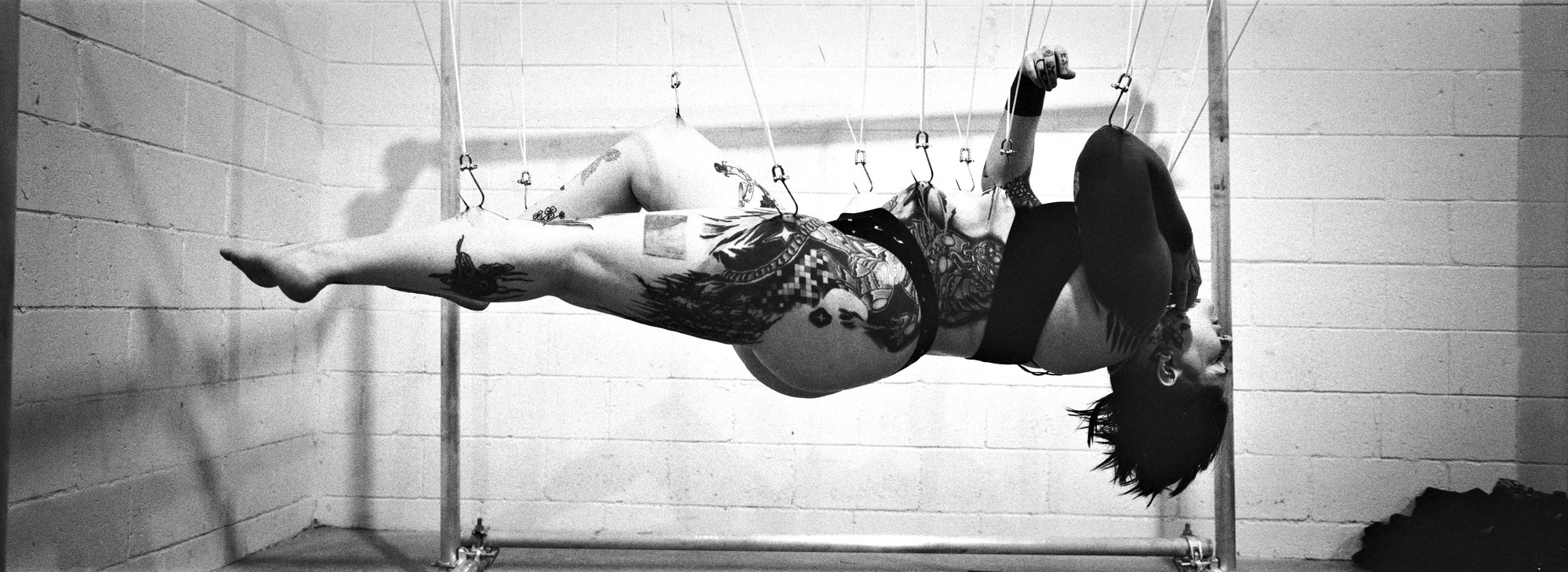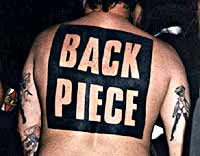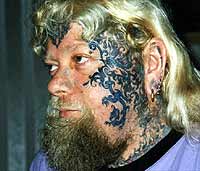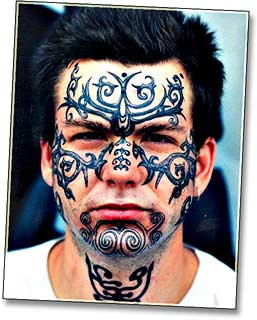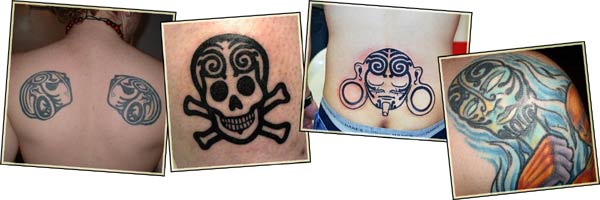
Young people unite: Body modification can
FIGHT THE POWER!
“When we lose the right to be different, we lose the privilege to be free.”
– Charles Evans Hughes
“Conformity is the jailer of freedom and the enemy of growth.”
– John F. Kennedy
More and more laws are being passed restricting the rights of young people to legally obtain body modifications. Even in areas where it is legal, schoolboards enact secondary rules restricting access to the (mandatory) education system to those with body modifications in order to ensure that these young people are not able to express themselves freely, and the similarly corporate controlled workplace also does everything it can to prevent those with piercings and other body modifications from obtaining employment. The establishment presents a series of deceitful justifications for this in an attempt to mask their true purpose: social control. In this article I will show that these laws and regulations are nothing but system sustaining safeguards to ensure that the education process continues to do its government defined role — the production of a uniform social product — and that it is essential for young people to defy these laws en masse.
Let me put it simply: laws restricting body modification have nothing to do with public safety. They exist exclusively to protect the interests of the corporate and political power structure and by tolerating them, we empower our oppressors.
I should note that the history and political issues I raise here are predominantly American and Canadian, but, like it or not, the United States does tend to define where the rest of the world is going as it plows our path to the future. Think of it as the canary in the mineshaft.
The lies they tell to justify themselves
Access to body modification tends to be restricted for young people, both in- and outside the school system, for a number of false stated reasons. I’ll mention a few here again, but it’s a subject I’ve written about previously (for example, in Joe Hatred Strikes Again!), so I’ll be brief. The point is that the listed reasons are lies (and obvious ones at that), and once we’ve revealed that, we need to start asking ourselves what the real reasons are.
Body modification as an indicator of “risky behavior”
It’s regularly written that there’s a link between body modification and activities such as drug use and adolescent sex. Ignoring the fact that the studies claiming this are wholly unscientific due to inadequate and non-representative sample groups, let’s assume for a moment that the statement is true. Now let’s examine two other examples of true statements:
- “If someone points a loaded gun at you and pulls the trigger, you are more likely to die a violent death than someone who has not been shot at.”
- “During slavery, a free man was more likely to engage in financial fraud than a slave.”
In the first statement, there is a direct cause and effect — the first action (the gun firing) leads to the second (the violent death). In the second statement, which is also true, there is no cause and effect — freedom does not lead to crime, even though a free person is more likely to commit a crime. A person who is inclined to risky behavior is perhaps more likely to be attracted to body modification, but taking the body modification away from them has no effect on their interest in the risky behavior — one could argue it risks increasing it as the body modification acts as a channel for those drives (ie. a safe way to express them), but that’s a debate for another column.
Body modification as disruptive to the education process
Some people have claimed that body modification needs to be kept out of schools since it is unfair to other students who are not able to concentrate on their studies because of the distraction. As I’ve pointed out before, I find it difficult to believe that young people are this shallow, and in any case, this argument could equally be applied to expel ethnic minorities, the disabled (wheelchairs, crutches, braces, and disfigurements in general all have the potential to be just as distracting), or even exceptionally attractive or unattractive students.
The real reason that this justification is clearly deceptive is because it’s too late. If this was the reason, it would have been implemented when body modification was rare. When I was in school over ten years ago, the schools gave me no grief for having a mohawk or stretched piercings. However, now that it’s becoming common — even normal — it’s perceived as a threat.
Body modification as unhealthy
Just like we do not allow young people to smoke cigarettes or drink alcohol, many have suggested that we need to stop them from engaging in the “dangerous” activity of body modification. The problem with this statement is that there is effectively zero evidence showing that responsible body modification is dangerous, and the little evidence that there is shows that any risks that do exist are a fraction of those that apply to activities that we embrace as a culture — from organized sports to driving, or even junk food (which I discussed in a previous column, Ban it all!).
Others have made statements such as “piercings aren’t safe in a growing body” or “young people can’t take care of their piercings”, which are both patently false. There’s no evidence that body piercings shift badly due to growth when placed properly — the only “evidence” I’ve ever seen illustrating this theory is more likely piercings done poorly from day one (after all, the law is such that few talented piercers will take the business risk losing their shop for piercing a minor — leaving them to end up in the hands of what are all-too-often bottom-quality piercers). As far as the latter claim, it’s an offensive and ageist statement that I feel is barely even worth dignifying with a response any more than a claim such as “blacks and women shouldn’t vote”.
But, since so many people believe that body modification requires more maturity to take care of than a fourteen year old can muster, let me point out this: taking care of a body piercing is no more difficult than cleaning oneself or taking care of a minor injury, something which we routinely expect adolescents to be capable of. Children are going through puberty these days as young as eight years old — surely those issues are far more difficult to cope with than a navel ring? And in any case, historically youths have had no difficulty dealing with the responsibilities of healing even large scalpelled piercings or scarifications — unless of course we are arguing that Western youths are somehow radically less competent than those in “simpler” cultures (and yes, given the statements about the education system I am about to make, I appreciate the irony in that suggestion!).
“We know what’s best for you”
Kids shouldn’t do this because it’s an expression of some sick kink or gateway into sadomasochism. Kids shouldn’t do this because no one will hire them looking like that. Kids shouldn’t do this because it’s just wallowing in mental illness. To that I simply respond, “faith based logic.”
Ultimately these types of issues tend to be nothing more than one group trying to force its social ideals on another — often with almost pathological zeal and hatred. As one reader writes in response to tattoos being on the cover of the The Spectrum, a paper in Utah:
“I’m looking at the July 11th edition of Where It’s At. I have to hold it together because I was so angry upon seeing the cover that I tore it in half. You must have the idea this is Haight-Ashbury or Los Angeles or San Francisco. Just to remind you, this is good old conservative St. George. That kind of salacious drivel we don’t need here. Raising children is hard enough without you glorifying destruction of one’s body. The tattoo claiming, ‘Your body is God’s temple; it’s up to us to wallpaper it’ is so much evil nonsense. Personally my reaction is one of revulsion and nausea when I see this form of ‘art.’”
I won’t begin to comment on the level of psychosis and pure hatred that it takes to tear up a newspaper because the cover upsets you, but “God says it’s wrong” is a cop-out in that it offers no evidence for its spiteful claims, and creates a debate that “by divine proclamation” denies any right to respond. Let me let you in on a little secret — assuming God exists, God’s first interest is in the promotion of love and happiness. To suggest anything else for an omnipotent figure would paint Him as evil. Not only that, but nowhere in the Bible is there any dictate against body modification (the laws of Leviticus which briefly mention funerary cuttings are later overturned as “the old law” in Romans) — this is the word of man masquerading as the word of God.In any case, while wisdom may often come with age and experience, it’s not an automatic thing — man may be justified to God by acts of faith and not acts of law, but here on earth if a claim is made, it has to be backed up with facts. “Sick”, when it comes to personal expression, is simply a product of personal and cultural bias — for example, many would argue that to adhere to the mold is a betrayal of what it means to be human.
As far as issues such as the job market, factors are in such flux that it’s unreasonable to make such predictions. Body modification is mainstreaming at an incredible rate — studies show that 30% of Americans have a body piercing other than their earlobes, and according to Ohio University one in seven have a tattoo, with dramatically more in younger demographics (a 10:1 ratio according to some studies, which suggests we will see a generation where body modification is actually the norm). It’s very quickly becoming a modified world and given the permanence of these activities, there is no risk of “the trend disappearing”.
The mental illness issues are deceptive as well. Body modification is a form of communication and expression; studies are very clear that restricting the ability to communicate or self-express is one of the most detrimental things you can do to a mentally ill individual — most treatment involves the encouragement and facilitation of communication. In the rare cases where the body modification actually is an expression of something wrong on the inside, the body modification is a healing factor or at worst a symptom, rather than a contributing part of the problem.
It’s just a stupid trend that people are going to regret later
In my previous column, The Benefits of Being Different, I discussed how while there is a move to shift body modification into a commodified trend and group fashion, body modification in the sense discussed on BME is ultimately self expression rather than herd expression. As far as “regretting it later”, even if it turns out to be a trend and all but disappears in ten years, because of its permanence and because such an incredibly high number of people have taken part it must lose its discriminatory value.
I am reminded of a scene in the Star Trek episode, “Past Tense”, in which Dax, an alien with spots on her face and body very similar to those of Beki B (a model recently featured on the cover of In The Flesh, a book on the “cultural politics of body modification” by Victoria Pitts), travels back in time to to 2024, and meets an official named Chris who helps her obtain ID:
Chris: You know, those are… very unusual.
Dax: (laughs) Oh, you mean my tattoos?
Chris: That is amazing work. Where did you have them done? Japan?
Dax: How did you guess?
Chris: Well, I used to have one myself. A Maori tribal pattern used to go all the way down my arm. Got it in highschool back in the nineties like everybody else… Of course I had to have it removed. Well, you know how it is. To get the governmnet contracts you have to look like all the rest of the drones… Does that make me a sell-out?
Dax: Probably, but I won’t hold it against you.
I’m sure that if this turns out to be a trend, there may be a “fear the mullet”-like backlash while the trend dies, but I find it highly dubious to suggest that any long term damage will be done socially to those with body modifications — there are simply too many of us.
The History of Modern Schooling
To understand why the school is a battleground on this subject, one must examine its history and modern role. In the mid 1800′s, young Americans were some of the best educated and most free individuals on the planet — and America had no formal education system (being largely derived from the guild — apprentice — system of learning that embraced “learning through doing”). Schools were locally organized and had no rigid structure such as state testing, national textbooks, or even a defined curriculum. Children learned to read young, and because the US had rejected European copyright law, academic books and literature were readily available and consumed by the lower classes. The end result was an exceptionally well educated population that truly embodied “the American dream”.
The problem was that the liberty that these people embraced — and the spoils they demanded to earn (this was long before the concept of the welfare state) — ran contrary to the growing corporate power in the West, as well as the political corruption that sought to conglomerate control in increasingly expansive and wealthy federal hands. In 1888, the Senate Committee on Education wrote:
“We believe that education is one of the principal causes of discontent of late years manifesting itself among the laboring classes.”
They realized that once the lower classes were educated, it became crystal clear to them that the system was not treating them fairly or equally, and that they would demand a fair share of the country’s opportunities. Over the next twenty years, the US radically overhauled its education system to combat a well informed populace, with an end goal of producing adult infants with little ability to think independently. They worked to eliminate the ability for people to learn on their own by dragging out the education process, replacing it with mind-numbing repetition and learning through memorization, rather than understanding. The goal also included coaching students into blind patriotism and consumerism. John Dewey, one of the fathers of modern education, wrote in 1897:
“Every teacher should realize he is a social servant set apart for the maintenance of the proper social order and the securing of the right social growth.”
How often have you heard that a teacher’s role is to mold young impressionable minds, to prepare them for life (not life in the independent sense of the word, but life in the sense of their “duty to the machine”) — that is, to turn them into good little soldiers, happy to be ambitionless drones, working for the sole purpose of raising money to hand to their corporate slaveowners? William Torrey, the US Commissioner of Education at the turn of the 20th century wrote of his students:
“Ninety-nine out of a hundred are automata, careful to walk in prescribed paths, careful to follow the prescribed custom. This is not an accident but the result of substantial education, which, scientifically defined, is the subsumption of the individual.”
John Taylor Gatto, who quit teaching in 1991 to become a school reform activist while still holding the New York City Teacher of the Year award he was just given, writes:
“Great corporations, great universities, government bureaus with vast powers to reward or punish, and corporate journalism increasingly centralized [control over the education process] in fewer and fewer hands throughout the twentieth century, keeping a steady hand on the tiller. They had ample resources to wear down and outwait the competition.
The prize was of inestimable value — control of the minds of the young.
After 1900 the new mass schooling arenas slowly became impersonal places where children were viewed as human resources. Human resource children are to be molded and shaped for something called The Workplace, even though for most of American history American children were reared to expect to create their own workplaces.
In the new workplace, most Americans were slated to work for large corporations or large government agencies, if they worked at all.
Not only was the new form of institution spiritually dangerous as a matter of course, but school became a physically dangerous place as well. What better way to habituate kids to abandoning trust in their peers (and themselves) than to create an atmosphere of constant low-level stress and danger, relief from which is only available by appeal to authority? And many times not even then!
Horace Mann had sold forced schooling to industrialists of the mid-nineteenth century as the best “police” to create moral children, but ironically, as it turned out in the twentieth century, big business and big government were best served by making schoolrooms antechambers to Hell. School became jail-time to escape if you could, arenas of meaningless pressure as with the omnipresent “standardized” exams, which study after study concluded were measuring nothing real.
The new purpose of schooling [is] to serve business and government … [achieved] efficiently by isolating children from the real world, with adults who themselves were isolated from the real world, and everyone in the confinement isolated from one another. Only then could the necessary training in boredom and bewilderment begin. Such training is necessary to produce dependable consumers and dependent citizens who would always look for a teacher to tell them what to do in later life, even if that teacher was an ad man or television anchor.”
A truly terrifying and dystopian vision of the system that we are currently watching play out on a world stage, which Gatto has documented impeccably in his book The Underground History of American Education.Now that you understand why the state and the corporation instituted the modern education system — to produce compliant and patriotic consumer drones — let’s take a look at how body piercing and body modification fit into that equation.
What are the real effects of pierced kids?
Over the past month BME has been actively conducting the largest controlled study of people with body modifications ever done (click here to learn more about this survey and to browse its results). As of this writing approximately four thousand people have been interviewed, with just over two thousand of those being 21 years old or younger. Of those people, it is true that, as the mainstream claims, 80% have tried marijuana, and 84% have engaged in sexual intercourse (with about a third having done so before the age of sixteen), but let’s take a look at some of the other results that they don’t tell you about.
In the absence of anything suggesting negative effects of body modification — mental or physical — I believe it is important to ask the question, “how do you feel?” In deciding whether something that doesn’t harm anyone else is valid or not, we ought to be investigating how it affects the way the bearer perceives their life. In the response sets below (limited to those 21 and under), I have marked the positive answers in green, and the negative answers in red, with the neutral answers marked in blue (and I’ve left out the people without piercings if you’re wondering why the numbers don’t fully add up):
 


As you can see, in a truly overwhelming majority, those with body modifications report back positive effects on their life, with virtually zero reporting back anything negative. You can browse the full survey data for yourself, but almost universally the only negative effects reported involve finding oneself the brunt of bigotry — and we can no more fault the modified with this damage than we can blame blacks for the actions of the Ku Klux Klan. Sure, “freaky kids with nose studs” made that decision for themselves, whereas people don’t choose the color of their skin, but that’s irrelevant — it’s simply a piece of misdirection intended to allow one to get away with blaming the victim, rather than the aggressor. It’s like saying, “but look how she dresses — she was just begging to be raped!”
The fact is, people with body modifications become happier, more self-determined, and more willing to define their own lives on their own terms (hence the “risky behavior” I suppose) — exactly what the establishment and those who seek to sustain the status quo are afraid of. Now, maybe you’re saying “but healthy people shouldn’t need these crutches; harming yourself to achieve happiness is nonsensical.” There are many things that don’t add up on their own. To give an oft-cited example, the cost of policing a bank robbery is almost always higher than the amount of money stolen — that is, money would be saved by simply repaying the bank with taxpayer money, rather than going to the great expense of capturing and prosecuting the culprits. However, we understand that the larger effects (the damage to society) if we were not to use this “damaging crutch” would far outweigh any losses in the acceptance of the crutch. To give an example closer to home, recent studies by the American Society for Aesthetic Plastic Surgery showed lower levels of depression as well as “very significant improvement in quality of life” following cosmetic surgery — and such surgery is of course an order of magnitude more dangerous than body modification.
The fact is that even while over-emphasizing the small amount of damage done by body modification, when it comes to improving the lives of those involved, it is a net gain scenario. To put it simply, all things considered, it improves lives and makes people happy. And those involved feel very strongly about this — not only do over 70% of these youths say they’d not take a better job in exchange for removing their modifications, but 61% go so far as to say they’d actually choose a worse job in exchange for being able to keep their body modifications.
These are people who can’t be bought. To put it simply, they’re not slaves.
So why are these rules really in place?
As I mentioned earlier, high quality education was not perceived as a “threat” until it started to affect the ambitions of the lower classes. President Woodrow Wilson once said:
“We want one class to have a liberal education. We want another class, a very much larger class of necessity, to forego the privilege of a liberal education and fit themselves to perform specific difficult manual tasks.”
He said this while describing his goals for the future of business in America. The Rockefeller Education Board agreed, stating:
“We shall not try to make [students] into philosophers or men of learning or men of science. We have not to raise up from among them authors, educators, poets or men of letters. We shall not search for embryo great artists, painters, musicians, nor lawyers, doctors, preachers, politicians, statesmen, of whom we have ample supply. The task we set before ourselves is very simple…we will organize children.”
That is, education first and foremost must maintain the status quo; it must keep the class system stable, and it must keep ideas from flowing between demographic groups. The wealthy are able to maintain themselves due to the sheer bulk of their money — I hope it’s clear that the role of the schools in this caste system is primarily to repress, not to empower. Any ideas that break those molds, that run contrary to that conformity must be immediately destroyed lest they threaten the system. In the 1950s we watched rock music be attacked when it moved from black communities to white communities (where it was eventually commodified and lost its meaning), in the 1970s punk rock was attacked when it moved up from the lower classes (also diluted into commercialism), and most recently hip hop was attacked as it moved out of the ghetto into the suburbs. In White America, rapper Eminem says:
“See the problem is I speak to suburban kids
Who otherwise woulda never knew these words exist
Whose moms probably never woulda gave two squirts of piss,
Till I created so much motherfuckin’ turbulence…
Surely hip hop was never a problem in Harlem only in Boston”
While there are forces working to commercialize the “rebellion” and individualism in body modification (as discussed in the previous columns on indigenous cultures and on class warfare), the current predominant drive is to try and squelch it at its root by blocking access to the next generation (who are recognizing its value in growing numbers).When social scientists claim that those who engage in body modification also engage in other “risky behavior”, what they’re really saying is that those with body modifications are less likely to accept the rules, and more likely to decide for themselves what is right and wrong in their lives… and this is exactly what the last hundred years of the education process have been fighting to stop. In some ways, body modification is the single largest threat the system is currently facing.
When it was just some S&M characters doing it in the closet, they didn’t care — it was going on behind closed doors, and only affecting adults who desperately wanted to keep their kinks a secret, so they still played the game. When it was just gays and lesbians doing it, they didn’t care — probably hoping that they’d marginalize it in the process with homosexuality being a relatively stable minority rather than a growing threat. When it was societal outcasts they didn’t care — it just made them easier to identify — but now that it’s affecting their kids, and affecting enough of them to radically change society, they know that they have to stop it before personal freedom and expression becomes normal and acceptable.
And you can bet they’ll use every deceptive dirty trick they can think of.
Who is “they” you ask? Is this kind of like “the man”? Who it is at this point is difficult to pinpoint, because no actual person or even group of people exist any more — in the past one could blame the aristocracy that initiated the process, but it is far more convoluted than that now. Ask yourself who owns a large corporation (since large governments at this point in Western nations are almost wholly corporate owned and controlled). Certainly there are people at the top of the corporate hierarchy that manage to skim off significant resources and are motivated to help sustain it out of greed, but they don’t actually own the corporation or society, and certainly have no power to universally control it.
Others would say that it is the shareholders, or the voters, that own the corporation or government, but it’s obvious that while they do take part in the system, their value is largely symbolic and they carry little control as individuals. The fact is that at this point larger, older organizations own themselves — no one is in charge. They exist with one drive alone, as their free market model dictates: survival and market domination. In the case of governments and megacorporations which exist in a monopolistic state, they do this by sustaining the system.
In the 1997 movie Cube, the characters find themselves trapped in a homicidal maze, symbolically representing the megacorporation. As the characters debate the question why, one of them explains that while it once had a function, no one remembers it any more:
“There is no conspiracy. Nobody is in charge. It’s a headless blunder operating under the illusion of a master plan. Big Brother is not watching you.”
As another character points out, there is no establishment conspiring against us — just guys at desks doing their jobs. The monster is headless and soulless; as they say, it’s not the individual player that causes our problems, but the game itself. What are we going to do about it?
Step one: Don’t let them kill body modification
First we need to stop the efforts to kill or stem body modification by resisting these rules and regulations — and by responsibly and logically proposing alternatives that find a middle ground which protects both our safety and our liberty. That is, we should support laws that ensure safety standards and responsible practitioners, but we need to stand up against laws that actually restrict the artform — for example, laws in some states banning suspension, dermal punches, and even certain styles of piercing and jewelry (such as the laws in Florida banning the use of Tygon in piercing).
Call their bluff when they’re overstepping their power. Many of the restrictive anti-modification laws are a violation of clearly defined civil rights. Not only that, especially in the case of school rules, the people making the rules may not even have the authority to do so — in many cases it has been as simple as pointing this out to make the issue disappear a la the young child shouting “the Emperor wears no clothes!”
Use the media to your advantage. One of the reasons they think they can get away with these actions is because they do it in the shadows. Especially in the case of school suspensions over piercings, it’s not uncommon for the decision to be reversed with an apology as soon as the media becomes involved — since it can very quickly result in a hailstorm of negative national attention that risks the jobs of the people responsible. Body modification is still a hot topic for the media and they love doing stories like this, and are very often extremely sympathetic.
In addition to direct involvement with the media, letters-to-the-editor are surprisingly effective and can reach a large audience. If your local area enacts restrictive laws, be sure to write letters to all the local papers and have your friends do the same in their own words. When you’re doing so, be concise and polite — read your letter over a few times and make sure that your argument is well constructed and will appeal to the common sense of readers… and have a sense of humor — while crazy kook letters are published, the ones that help the cause are ones that are well written and fun to read.
Talk to your parents; try and make them understand you. If you’re a minor, your parents will have as much legal say over your life in these matters as you do. They can act as a powerful advocate for you, so if you can help them understand that body modification is something positive in your life, that’s not hurting you, they can speak on your behalf — and going back to the media, the media loves united families — having a parent say “I love my pierced daughter” not only speaks to the public in general and makes for good TV, but it inspires other parents to say, “hey, maybe my kid’s not so bad after all.”
Remember, the government is in theory your representative. Your local town council, school board, state representatives, and so on, are all voted into power by you and your family. If you send them a strong enough message, and they feel that their constituents disagree with something that’s happening, it is their duty to act as your advocate and correct the wrongs (and they’ll do it out of self-preservation). Not only should you be writing letters to and calling your local government, but you could also collect polls and get general public support.
And never forget — the squeaky wheel gets the grease. So called “special interest groups” have so much power not because they have the voting numbers, or because they are “right”, but simply because they are very vocal and good at lobbying politicians. When you’re writing your representative, be sure though to follow the same rules as writing the media — be polite and concise, and when possible, provide backup for your statements such as relevant studies.
Be the best you can be. This may be the most important point in this section. I can not emphasize enough how important it is for you to get good grades and be a positive part of your community. If you’re a problem student that doesn’t play sports, doesn’t volunteer at the Red Cross, and is failing half their classes, you’ll just fall into the stereotype and it’ll be hard to argue your case. On the other hand, if you’re a B+ student that works hard, is friendly, worked on the school yearbook, and volunteers at the local animal shelter on the weekends, you can make a very strong case for yourself — they’ll be left having to explain why body modification somehow “voids” all your contributions to society.
Consider civil disobedience. When all else has failed, you can of course practice the time-proven method of simply breaking the unjust laws, forcing them to either prosecute you or discard the law. There are several US states that still have restrictions against tattooing, and in them a small handful of brave artists have performed public tattooing for the specific purpose of being arrested to force the government to justify their anti-freedom actions in court. Many have spent significant time in prison for this, and some have even been successfully prosecuted.
Most recently this happened in Tulsa, Oklahoma, as reported by KTUL:
Those who are caught giving tattoos [in Oklahoma] go to jail. Two men spent several hours behind bars after police raided a business Thursday night.
“They came in while were were tattooing, said we were the police,” says tattoo artist Shawn Morrow.
Morrow is back in his store where he encountered police Thursday. They arrested him and an employee in the back of his shop for giving tattoos. And it wasn’t unexpected.
“It was bound to happen,” Morrow says. “Somebody has to be the example, someone has to fight for the the cause. I’m willing to fight the cause, go to court and press this issue to get it legalized.”
Morrow says the arrest is a first step. [He] says allowing tattoos shops to operate publicly would make it much safer.
“If they were really worried about the health concerns of tattooing, then they would legalize tattooing,” he says.
Other artists, such as Diane Maiden of Manchester, New Hampshire, take a more active role, by suing their local governments over such restrictions, often with the help of groups such as the ACLU. Unfortunately these cases still often lose, with courts agreeing with the government that tattooing is not valid art or communication, and thus not protected under the First Ammendment. It’s still a long battle ahead, and those artists fighting it deserve our thanks. Don’t let them turn us against each other; don’t succumb to greed. When you’re running an above-board business, running it “criminally” is ultimately damaging to that business… As such, it’s not uncommon for some less scrupulous body modification business owners to, instead of fighting unjust laws, use them to attack their competition — I’ve even seen numerous cases where artists will attempt to manipulate local government into enacting laws that would in effect allow only them to stay in business. I am reminded of Afghanistan where rival warlords reported each other as al Qaeda operatives to the Allied forces who then ran bombing runs that served not the war against terrorism, but simply empowered one drug warlord over another.
To cite a recent example, at a private BME event being hosted in Chicago flesh pullings were being planned. The piercing would of course be performed by a local piercer — another local piercer heard about this and because there are regulations in the area making such rituals illegal, he spoke with the health board and supported them in threatening the organizers, allegedly in the interest of shutting down his competition — and as a result those aspects of the event had to be canceled. Some might argue that he was in the right; after all, he was operating legally, and those at the BME BBQ were about to break the law, and no one would claim that suspension is risk-free. I briefly interviewed the piercer responsible:
BME: Why are you trying to get the Chicago BBQ shut down?
S: I got a call from the Health Department on Thursday asking if I was involved with suspension at the so called “event”. My reply was that I wouldn’t risk my career just to break the law.
BME: But this isn’t the first time you’ve used regulations to strike at your competition. What is this all for you? Marketing?
S: I’m in no way ashamed that I tell people the truth. Body suspension is not protected as an art form in my state. I’m not scared to let people know that they’re putting themselves at risk. I’m not into telling people who’s right or wrong, but facts remain facts.
The problem is that when you support the law’s injustices, even passively, and instead of fighting for this community or for the rights of its members, decide to “play the game” and use it to your advantage (even if it means hurting others), you are holding up these injustices and empowering them. Having personally seen lives changed and even saved by body modification and body ritual, I could never bring myself to sink to such a level, but the sad truth is that I’ve had variations on this conversation — usually far worse — dozens of times with dozens of different piercers.To those body artists who fight against this community in exchange for a second studio and a few more dollars in the bank, I remind them that one day they will need to answer for their treachery and betrayal. As they say, karma’s a bitch…
Step two: Don’t let them commodify body modification
When it’s clear to them that they’ve lost the battle to eliminate body modification, their “plan B” (as it was with rock, punk, and hip hop) will be to commodify and appropriate and turn it into a trend that they can use to serve their own goals. It is essential that we resist their efforts to keep us docile and subservient on both fronts.
We’re seeing the same happing right now with the RIAA in the US toward music “sharing” technologies (such as Napster, KaZaA, and so on). First, when the technology was young, and the threats seemed fringe, they simply ignored the P2P community. Then, as the popularity increased, they fought to destroy it through increasingly aggressive lawsuits and attempts to legislate. We’re now seeing the final phase begin, and an increasing number of companies (Apple’s iTunes coupled with its iPod player for example) are learning how to use these technologies to both kill off the original threat and profit from it.
At its simplest, always make sure your modification interests revolve around you and expressing yourself, rather than something you’ve been told to believe in — don’t go buying that Tickle Me Elmo Bellypiercing Kit that gets you a discount when you wear it at McDonald’s. Remember, when it comes to commodification, they can’t do it if you won’t buy it!
Step three: Above all else, know yourself and be yourself
If you want a piercing, get it. If you want your face tattooed, do it. Make sure everyone you know does the same if they want to. However… that doesn’t mean rush out and get that FTW on your forehead — rights do come with responsibilities as well.
If you take body modification seriously (and odds are if you’ve read this far through this you do), then you know that it’s a powerful thing — use it right, and it’ll dramatically improve your life. Use it wrong, and it’ll do nothing to improve your life, and may even hurt you, especially if we’re talking about things like facial tattooing. If you’re honest with yourself, and care about yourself, then you’ll take the time to make good decisions when it comes to your body — or at least learn to judge which impulses you feel are “genuine” and which are passing fancy.
Have fun and be happy, and remember, body modification is about you!
And remember, the only reason that people don’t have rights is because they don’t stand up for them.
I realize I’ve been brief in this section; in future columns I will talk about cases where resistance was successful, as well as illustrating those that failed. While there are parallels between what we’re facing and the civil rights movement in general, freedom of expression is much less agreed upon as a universal right, so it’s easier for them to strike at us with what would otherwise be instantly recognized as bigotry.
This is a Slave Revolt
Let’s be clear here — we’re talking about a slave revolt… and that means that if we lose, the lot of us will find ourselves crucified along the side of the road as an example to those who’d also seek to be individuals — some would argue that’s already happening. Some might even argue that there’s something to be said for the life of a slave; in theory, it’s easy — your needs are provided for, you know what you’re supposed to do and think, and as long as you do what they say, life’s worries are minimized. But at the same time, life’s borders become very narrow, and we’re reduced to cogs in a corporate machine.
And, as I will illustrate in my next column, as cogs in the machine, we will be replaced. This is not only a fight worth fighting for philosophical reasons, but a fight for the survival of our species as we know it.
Until then,

Shannon Larratt
BMEzine.com
PS. Enormous thanks is due to John Taylor Gatto for his incredible research on this subject which helped inspire this column. I whole-heartedly recommend his book on this subject (available at johntaylorgatto.com), and I would not have been able to compile this without his help. In addition, I think it’s also important to note that there are many fine teachers working to reform the system from within — they deserve great credit for doing so.
|


